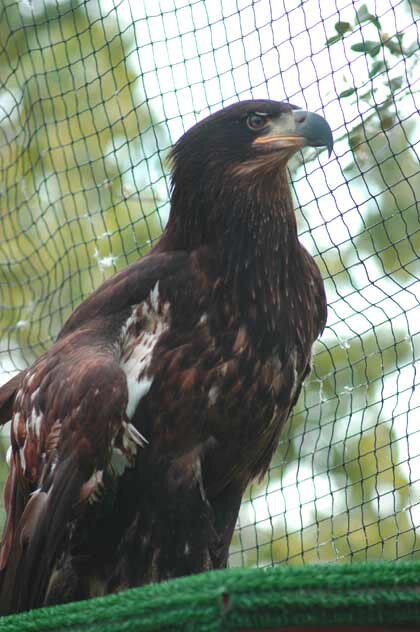Bald Eagle
Santa Cruz Island
In 2002, funding provided by the Montrose Settlements Restoration Program allowed IWS to begin a five-year feasibility study to determine if bald eagles could be successfully restored on the northern Channel Islands, California. The project objectives were to release 12 bald eagles per year on Santa Cruz Island (hereafter Santa Cruz) by hacking and then to carefully monitor the eagles' movements, forage use, and survival. Forage use and analyses of prey samples are to be used to evaluate the potential source of organochlorine contaminants that could affect the establishment of a self-sustaining bald eagle population. Santa Cruz is located approximately 20 miles off the coast of Ventura and Santa Barbara counties. Santa Cruz is the largest of the eight California Channel Islands, measuring about 38 km in length and 12 km wide at its widest point. The National Park Service (NPS) owns and manages the eastern 24% of the island and The Nature Conservancy (TNC) owns and manages the western 76% of the island.
Since June 2002, IWS has released 63 young bald eagles from two hacking (release) towers located on the NPS portion of Santa Cruz. Each tower has two cages, each of which can hold up to four young eagles being prepared for release. The eaglets were produced by the Avian Conservation Center at the San Francisco Zoo or collected from wild nests near Juneau, Alaska when they were about 8 weeks old. The birds were kept in the cages until they were ready to fly at about 12 weeks of age. They were fed a variety of foods that they encounter once released and we monitored them using a closed-circuit video system to insure that each bird was eating and behaving normally.
When the birds were approximately 11 weeks old, we fit each bird with a combination satellite/VHF transmitter, light blue patagial wing markers, and federal leg band. The satellite transmitters record hourly GPS locations of the bird and then upload them to a satellite approximately every three days. We are then able to download the data and determine where the birds have been. You can follow the paths of some of these birds here.
When the birds were approximately 12 weeks old, we opened the release doors on each cage. It took up to two weeks for the birds to fledge from the towers. We continued to place food items in and around the towers to provide a known food source for the birds while they developed their flight/scavenging skills.
In 2006, two pairs of bald eagles successfully hatched one eagle chick each. These were the first known successful bald eagle nests on the California Channel Islands in about 50 years. One pair of these eagles was originally released on Santa Catalina Island in 2001 (Male K-10) and 2002 (Female K-26). The second pair was comprised of a Catalina male released in 2001 (K-11) and a female released on Santa Cruz Island in 2002 (A-04).
As of the end of 2009, there are estimated to be about 40 bald eagles on the northern Channel Islands (Anacapa, Santa Cruz, Santa Rosa, and San Miguel), including birds released on Santa Cruz, at least three Catalina-released birds, and a few unmarked eagles from the mainland.
There is a Discussion Forum set up for regular updates and discussion about the activities at nests.
Juvenile Bald Eagle
